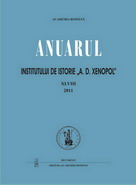THE TURKOLOGISTS FROM THREE GENERATIONS IN ROMANIA (1900-1945). NICOLAE IORGA – FRANZ BABINGER – MIHAIL GUBOGLU. SIMILITUDES – COLLABORATIONS – RESULT
THE TURKOLOGISTS FROM THREE GENERATIONS IN ROMANIA (1900-1945). NICOLAE IORGA – FRANZ BABINGER – MIHAIL GUBOGLU. SIMILITUDES – COLLABORATIONS – RESULT
Author(s): Dan ProdanSubject(s): History
Published by: Editura Academiei Române
Keywords: Romanian orientalistics-turkology; 1900; 1945; Institute of Turkology from Iassy; turkological scientific activity; turkological universitary didactic activity
Summary/Abstract: Romanian Turkology became a distinct part of national historiography in the late 19th century and the first two decades of the 20th century, on the basis of the quantitative and qualitative accumulations between the 15th and 19th centuries (the activities and scientific contributions of Frater Georgius of Transylvania, so-called “Captivus Septemcastrensis”, Nicolae Spătarul-“Milescu”, Dimitrie Cantemir, Ienachiţă Văcărescu, Dionisie Fotino). After 1878, the year of the European recognition of Romania’s Independence and that of Dobrudja’s reintegration into Romanian State, Romanian Turkology developed into two complementary directions: a. scientific and research preoccupations in the field; b. university – post university didactic-formative accomplishments and initiatives. These directions also continued between 1918-1948 as components of the progress in the Romanian scientific and didactic Turkology.
Journal: Anuarul Institutului de Istorie »A.D. Xenopol« - Iaşi
- Issue Year: XLVIII/2011
- Issue No: 48
- Page Range: 273-282
- Page Count: 10
- Language: English

